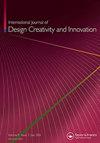A review of design fixation: research directions and key factors
IF 2.5
Q4 ENGINEERING, MANUFACTURING
International Journal of Design Creativity and Innovation
Pub Date : 2018-04-03
DOI:10.1080/21650349.2017.1320232
引用次数: 19
Abstract
Abstract Design fixation refers to designing under the influence of precedents with the inappropriate reuse of their features. With the aim of better understanding of design fixation and create a compendious framework, this paper reviewed 50 new empirical studies in this area. Design fixation studies are classified into (a) investigating conditions that affect design fixation occurrence, (b) proposing affordance sources, and (c) suggesting overcome instructions and methods. Results indicated that there exist eight key factors, namely designer, design problem, sources, design process, design outcome, designers’ goal, distance between source and problem, and similarity between source and design outcome. Finally, a new framework was developed on the basis of the key factors and variables. By synthesizing the variables and the findings of these papers, future research directions are proposed.设计固定研究综述:研究方向与关键因素
摘要设计固定是指在先例的影响下,对其特征进行不适当的再利用。为了更好地理解设计固定,并创建一个简明的框架,本文回顾了该领域的50项新的实证研究。设计固定研究分为(a)调查影响设计固定发生的条件,(b)提出可供性来源,以及(c)提出克服的指示和方法。结果表明,存在八个关键因素,即设计者、设计问题、来源、设计过程、设计结果、设计者的目标、来源与问题的距离以及来源与设计结果的相似性。最后,在关键因素和变量的基础上开发了一个新的框架。通过综合变量和这些论文的发现,提出了未来的研究方向。
本文章由计算机程序翻译,如有差异,请以英文原文为准。
求助全文
约1分钟内获得全文
求助全文
来源期刊

International Journal of Design Creativity and Innovation
ENGINEERING, MANUFACTURING-
CiteScore
3.80
自引率
27.80%
发文量
15
期刊介绍:
The International Journal of Design Creativity and Innovation is an international publication that provides a forum for discussing the nature and potential of creativity and innovation in design from both theoretical and practical perspectives. Design creativity and innovation is truly an interdisciplinary academic research field that will interest and stimulate researchers of engineering design, industrial design, architecture, art, and similar areas. The journal aims to not only promote existing research disciplines but also pioneer a new one that lies in the intermediate area between the domains of systems engineering, information technology, computer science, social science, artificial intelligence, cognitive science, psychology, philosophy, linguistics, and related fields. The journal covers, but is not restricted to, the following topics: ·Theories on Design Creativity and Innovation ·Cognition of Design Creativity ·Innovative Process ·Inventive Process ·Analogical Reasoning for Design Creativity and Innovation ·Design Synthesis ·Method and Tools for Design Creativity and Innovation ·Representation of Design Creativity and Innovation ·Education for Design Creativity and Innovation ·Concept Generation and Inspiration.
 求助内容:
求助内容: 应助结果提醒方式:
应助结果提醒方式:


